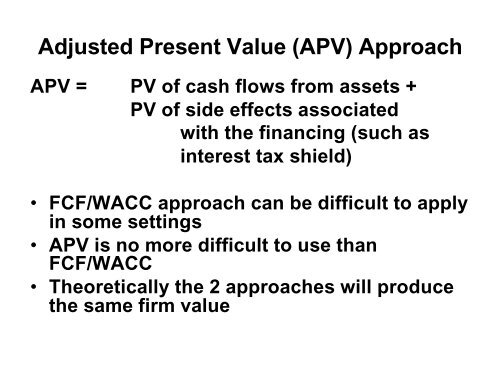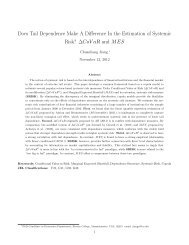Create successful ePaper yourself
Turn your PDF publications into a flip-book with our unique Google optimized e-Paper software.
<strong>Adjusted</strong> <strong>Present</strong> <strong>Value</strong> (<strong>APV</strong>) <strong>Approach</strong><br />
<strong>APV</strong> = PV of cash flows from assets +<br />
PV of side effects associated<br />
with the financing (such as<br />
interest tax shield)<br />
• FCF/WACC approach can be difficult to apply<br />
in some settings<br />
• <strong>APV</strong> is no more difficult to use than<br />
FCF/WACC<br />
• Theoretically the 2 approaches will produce<br />
the same firm value
Example: <strong>APV</strong> vs. FCF/WACC<br />
1. Debt in capital structure 0% 10%<br />
2. EBIT $120,000 $120,000<br />
3. Interest 0 4,125<br />
4. Profit before tax 120,000 115,875<br />
5. Tax 60,000 57,938<br />
6. Profit after tax 60,000 57,938<br />
7. Dividends 60,000 57,938<br />
8. Total pmts to security holders (3+7) 60,000 62,063<br />
9. Cost of debt 8.25%<br />
10. Cost of equity<br />
12.50%<br />
11. Market value of debt (3/9) 0 50,000<br />
12. Market value of equity (7/10) 500,000 463,500<br />
13. Market value of firm (11+12) 500,000 513,500<br />
14. Book value of debt 0 50,000<br />
15. Book value of equity 500,000 450,000<br />
16. Book value of firm 500,000 500,000<br />
17. Book value debt ratio (14/16) 0.0% 10.0%<br />
18. Market value debt ratio (11/13) 0.0% 9.7%<br />
19. WACC 12.0% 11.7%<br />
20. FCF $60,000 $60,000<br />
21. Market value of firm (20/19) $500,000 $513,500
<strong>APV</strong> procedure<br />
1. Calculate value of the firm assuming it<br />
is all equity financed (i.e. no interest<br />
expense)<br />
Discount rate uses CAPM and asset<br />
(unlevered) beta<br />
2. Calculate the value of tax shields<br />
(based on the difference in tax<br />
payments vs. the unlevered case in<br />
step 1).
<strong>APV</strong> Example<br />
Assume:<br />
Asset beta = 0.7 Long Term Treasury = 6%<br />
Market Premium = 7.8%<br />
From CAPM, Discount rate = .06 + .7*.078 = .1146<br />
Also assume: Terminal value = (approx.) 7 x FCF<br />
Step 1:<br />
Year: 1 2 3 4 5<br />
EBIT 100 108 116 124 134<br />
Tax @ 40% 40 43 46 50 53<br />
Capex 30 32 35 37 40<br />
Depreciation 20 22 24 26 28<br />
Increase in NWC 20 22 23 25 27<br />
FCF 30 33 36 38 41<br />
Terminal <strong>Value</strong> 287<br />
PV@11.46 27 26 26 25 24<br />
167<br />
Total PV 295
<strong>APV</strong> example (continued)<br />
Step 2: Calculate value of tax shield.<br />
Assume $150 of debt at 8% (pretax) initially outstanding & is<br />
repaid from available cash flow<br />
Year: 1 2 3 4 5<br />
EBIT 100 108 116 124 134<br />
Interest (=outstanding debt*.08) 12 10 8 6 3<br />
Profit before tax 88 98 108 118 131<br />
Tax 35 39 43 47 52<br />
Profit after tax 53 59 65 71 79<br />
Capex 30 32 35 37 40<br />
Depreciation 20 22 24 26 28<br />
Increase in NWC 20 22 23 25 27<br />
Cash flow available to pay down debt 23 27 31 35 40<br />
Ending Debt =<br />
(beginning debt – pay down) 127 101 70 35 0
<strong>APV</strong> Example (step 2 continued)<br />
Compare tax payments with vs. without debt. The<br />
difference equals the tax savings available from<br />
the interest deduction (tax shield).<br />
Discount tax savings at pre-tax rate of return on<br />
debt*<br />
Tax payments with no debt 40 43 46 50 53<br />
Tax payments with debt @ 8% 35 39 43 47 52<br />
Tax savings 5 4 3 3 1<br />
PV of tax savings @ 8% $13<br />
* assumes risk of tax shields being realized = risk of debt
<strong>APV</strong> example: non-interest tax shields<br />
Suppose in addition there is a tax loss carryforward of<br />
$100 million. This means that the first $40 million of<br />
taxes need not be paid.<br />
Year Tax savings Taxable Income<br />
Used<br />
1 35 87.5<br />
2 5 100<br />
PV of tax savings @ 8% $37<br />
<strong>Present</strong> value these savings at 8%, produces a value of 37<br />
for the tax loss carryforward.<br />
Conclusion: Total firm value =<br />
value of all equity firm (295) +<br />
side effects of financing (13 + 37) = 345.
RJR Nabisco buyout
RJR Nabisco buyout

















